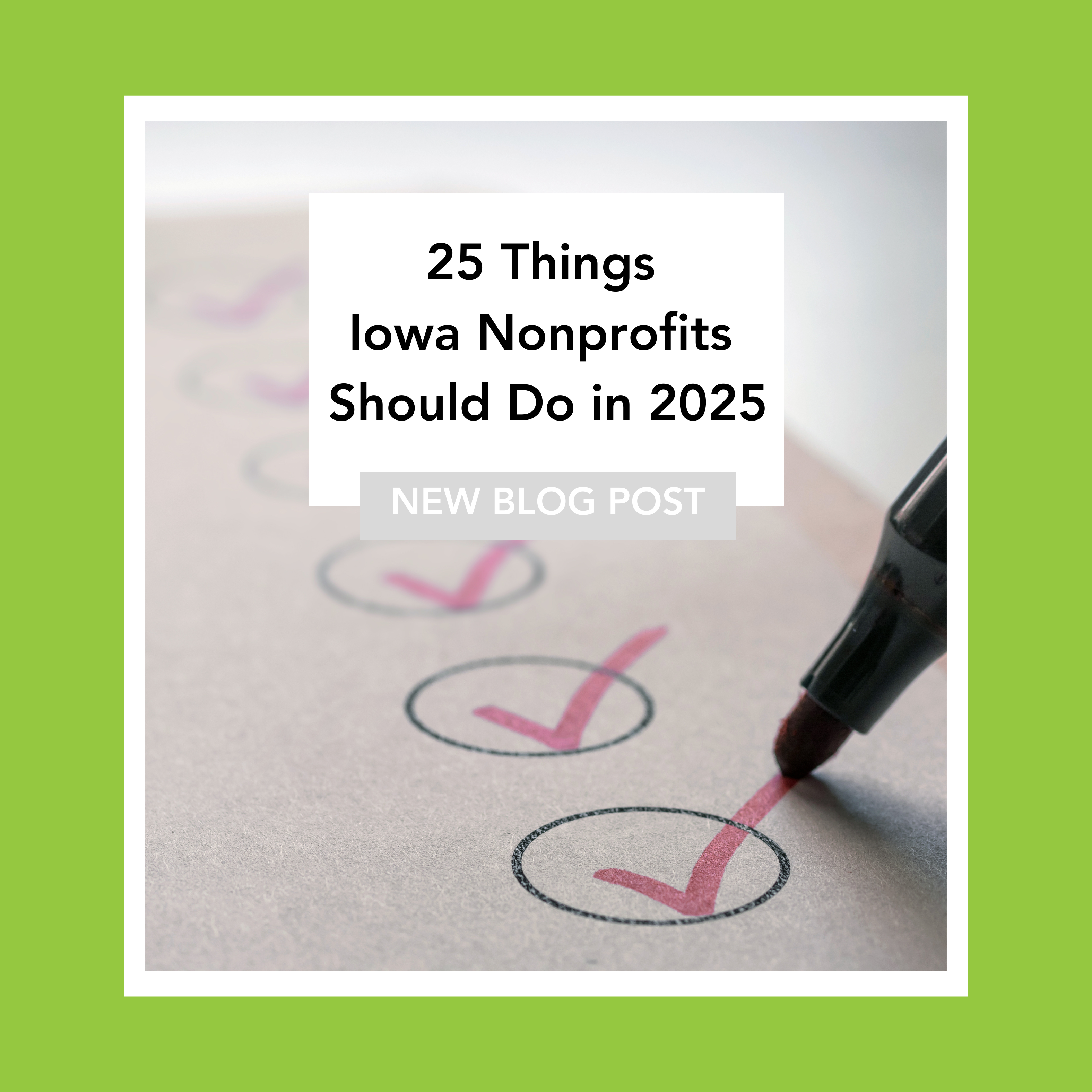
June 25, 2025
25 Things Iowa Nonprofits Should Do in 2025
The nonprofit landscape in Iowa is facing a perfect storm of challenges and changes. Federal and state funding is increasingly uncertain. Proposed laws like the so-called “Big Beautiful Bill” could significantly shift how we operate. Diversity, Equity, and Inclusion (DEI)—a cornerstone for many organizations—is facing public scrutiny. And tax law changes, like adjustments to the standard deduction, are making charitable giving more complex and harder to predict.
So how should Iowa nonprofits respond?
Ensure the rest of 2025 is your organization’s strongest year yet by tackling these 25 actionable steps to stay compliant, mission-focused, and future-ready.
1. File and Review Your Form 990
Each year, tax-exempt organizations must file IRS Form 990—a public document that details your finances, governance, and operations. The IRS uses it to confirm your continued eligibility for tax-exempt status.
Here’s why it matters:
- File late? You face a $20-per-day penalty.
- File incorrectly? Still penalized.
- Miss it for three years in a row? You lose your tax-exempt status and have to start over.
A Form 990 Review Policy helps prevent that. It should explain:
- How and when the Board reviews the draft,
- Who prepares and edits it,
- And how it gets finalized and submitted.
2. Define and Revisit Your Mission
Your mission is your organization’s north star.
2025 To-Do: Revisit it. Is it clear? Is it still relevant? Does it align with your current work? A well-crafted mission builds unity and guides better decision-making.
3. Audit Your Articles of Incorporation
Think of this document as your nonprofit’s legal DNA. It outlines your purpose and structure—and both the IRS and the State of Iowa have specific requirements.
IRS Requirements:
- Clear Purpose Statement tied to a recognized exempt category (charitable, educational, religious, scientific).
- Dissolution Clause explaining how assets are distributed if the nonprofit shuts down.
- Prohibition on Private Inurement (no personal benefit to insiders).
- Restrictions on Political Activity (no campaigning, limited lobbying).
Iowa Requirements:
- Unique Name and Registered Agent on file.
- Purpose Statement aligned with IRS.
- Member Provisions (declare whether you have voting members or not).
- Dissolution Plan consistent with state and federal law.
Go Beyond the Basics:
- List initial directors.
- Include indemnification clauses.
- Detail your amendment procedures.
2025 To-Do: Ensure you meet both IRS and Iowa standards—and go further where it makes sense.
4. Update Your Bylaws
If Articles of Incorporation are your constitution, Bylaws are your user manual. They spell out how your nonprofit actually functions day to day.
Make sure your Bylaws address:
- Mission & Purpose – Your organizational compass.
- Structure – Board roles, terms, officer responsibilities.
- Meetings & Quorums – When you meet, how decisions are made.
- Financial Oversight – Who controls funds and budgets.
- Amendments – A clear process to make future changes.
- Indemnification – Legal protection for board members.
- Dissolution – A plan for what happens if the organization closes.
2025 Best Practice Policies:
- Conflicts of Interest
- Confidentiality
- Document Retention
- Fundraising & Gift Acceptance
These policies are specifically referenced in Form 990. Don’t skip them.
Final tips:
- Review Bylaws annually
- Share them with all new board members
- Work with a nonprofit attorney—don’t DIY
5. Enforce a Document Retention Policy
This often-overlooked policy is essential for legal compliance and good governance. It outlines:
- What to keep (tax returns, board minutes, financials),
- How long to keep it,
- And when and how to securely dispose of it.
It should also apply to digital files, social media, and even emails.
Tip: Keep it simple and usable. A policy no one understands—or follows—isn’t helpful.
6. Reevaluate Fundraising Practices
Fundraising is a lifeline—and also a compliance concern. The IRS scrutinizes how nonprofits raise money in Form 990. A fundraising policy ensures:
- Ethical standards are in place,
- Donors and the public trust you,
- And your process is consistent and transparent.
7. Adopt or Refresh Your Gift Acceptance Policy
You’ve heard the phrase: “Don’t look a gift horse in the mouth.” In the nonprofit world? You absolutely should.
Imagine your favorite donor shows up with a racehorse—healthy, fast, and valuable. Do you accept it on the spot?
Of course not. You’d ask:
- Who will care for it?
- What are the liabilities?
- Can we even sell it?
- What if it draws the wrong kind of attention?
A strong Gift Acceptance Policy will:
- Prevent costly mistakes or liabilities,
- Ensure all gifts align with your mission,
- Clarify who approves and handles unusual gifts.
Pro tip: Post it online to set expectations with donors upfront.
8. Adapt or Update Your Whistleblower Policy
If wrongdoing is happening inside your organization, you want to know and your team needs to feel safe speaking up.
A whistleblower policy should:
- Cover everyone (employees, volunteers, contractors),
- Protect those who report issues in good faith,
- Outline how to report and investigate concerns,
- Discourage malicious or false reports.
It’s about building a transparent, ethical culture. It’s also explicitly asked about on Form 990.
9. Revamp Your DEI Policy
While it is currently under attack, DEI is still foundational. A meaningful DEI policy:
- Attracts diverse and talented staff,
- Builds trust with your community,
- Drives innovation through varied perspectives.
Ask yourself:
- Are your values and goals publicly shared?
- Are you transparent about hiring, pay, and promotions?
- Are your partners aligned with your DEI commitments?
- Are you tracking and reporting on progress?
10. Update Your Confidentiality Policy
Nonprofits operate in high-trust environments and a breach of that trust can be devastating.
A strong confidentiality policy should:
- Define what’s confidential (donor data, internal discussions, personal info),
- Explain who’s responsible,
- Detail what happens if the policy is broken.
Confidentiality isn’t about hiding things—it’s about protecting people and building trust.
11. Curate a Specific Social Media Policy
Social media is powerful and potentially risky. Your organization needs a clear Social Media Policy to protect your mission, reputation, and people.
What it does:
- Sets expectations for tone, content, and professionalism online.
- Applies to staff, volunteers, board members, and contractors.
- Helps prevent missteps that could damage your public image.
What to include:
- Platform coverage – From Instagram to blogs and DMs.
- Behavior guidelines – Respectful, inclusive language only.
- Posting rules – Who has access, and how content is approved.
- Confidentiality – No donor data, private info, or copyrighted material.
- Personal use – Clarify how personal posts reflect on your org.
Keep this policy updated. Online platforms evolve quickly and so do reputational risks.
12. Examine Your Volunteer Policy
Volunteers are ambassadors of your mission. A Volunteer Policy ensures they’re supported, protected, and aligned.
What to include:
- Purpose and mission connection.
- Role descriptions, time expectations, and training requirements.
- Code of conduct, confidentiality, and dress code.
- Contact and emergency information.
- Legal guidelines: liability, insurance, media releases.
- Feedback mechanisms to recognize contributions and improve experience.
This policy helps everyone feel valued and keeps your organization legally and ethically sound.

13. Set a Solid Foundation With Your Employee Handbook
Your Employee Handbook is more than an HR formality—it’s your culture codified.
Key contents:
- Your mission and values.
- Policies on anti-discrimination, harassment, benefits, time off.
- Remote work and tech usage.
- Compliance standards (tax law, fundraising rules, grant expectations).
- Performance review and training structure.
Must-haves:
- A disclaimer that it’s not a contract.
- An acknowledgment form.
- At-will employment clause.
- Language reserving the right to change policies.
A great handbook reduces confusion and boosts consistency, especially during growth or transition.
14. Ensure Clarity With Employee Agreements
Unlike handbooks, Employee Agreements are individual contracts. They clarify roles, expectations, and legal protections. They are especially critical for executive or specialized roles.
Include:
- Names and start date.
- Job duties, pay, benefits, and review schedule.
- Termination conditions.
- Legal protections (non-competes, dispute resolution).
- Signature lines for all parties.
A solid agreement protects everyone now and during leadership changes.
15. Outline Your Compensation Policy
A Compensation Policy ensures fairness, transparency, and IRS compliance, especially for executive pay.
Why it matters:
- Boosts staff morale and retention.
- Reassures donors.
- Prevents inconsistent or inflated pay practices.
What to include:
- Who approves salaries.
- How often compensation is reviewed.
- How comparability data is used.
- Rules for executive compensation and conflict-of-interest recusal.
- Revision procedures.
This policy should align with your budget, values, and public accountability.
16. Protect Your Nonprofit With a Conflict of Interest Policy
A Conflict of Interest (COI) Policy isn’t just best practice—it’s IRS-required.
It prevents:
- Insider deals
- Reputational harm
- Compliance violations
Your policy should cover:
- Definitions of conflicts
- Annual and ongoing disclosures
- Recusal processes
- Documentation procedures
- Regular training for board and staff
Transparency builds trust—inside and out.
17. Craft an Investment Policy
If your organization has reserve funds or endowments, an Investment Policy helps you manage them responsibly.
Include:
- How investments align with your mission.
- Who makes decisions (board, committee, advisor).
- Guidelines on risk tolerance, diversification, and returns.
- When funds can be used.
- How performance is monitored and disclosed.
Don’t have investment expertise? Bring in a professional and review your strategy annually.

18. Ensure Transparency With a Public Disclosure Policy
Nonprofits are legally required to share:
- IRS Form 990 and 990-T (last 3 years)
- IRS determination letter
- Form 1023 (exemption application)
A Public Disclosure Policy outlines how you’ll comply and what else you’ll proactively share (like Bylaws or Compensation Policy).
Openness builds credibility and reassures funders, partners, and the public.
19. Use Independent Contractor Agreements
Working with freelancers or contractors? A written agreement protects everyone.
Must-haves:
- Nature of the relationship (not an employee!)
- Scope of work and deliverables
- Compensation terms
- Deadlines and termination terms
- Confidentiality clauses
- Liability and insurance provisions
Iowa has strict rules—misclassification can lead to tax, insurance, and even criminal consequences.
20. Solidify Your Financial Policies and Procedures
Financial health = mission success.
Your Finance Policy should cover:
- Budget creation and approval
- Spending limits and authorization
- Cash handling protocols
- Monthly/quarterly reporting
- Audit guidelines
- Investment and reserve use
Review this annually to adapt to growth and challenges.
21. Update Your Personnel Files
No one loves filing—but consistent Personnel File Policies protect your nonprofit.
Include:
- Job descriptions, performance reviews, background checks, signed agreements
- Records of promotions or disciplinary actions
- Retain files for at least 4 years after employment ends
Do not include:
- Medical records
- Informal supervisor notes
- Investigation reports
Keep access limited and organized for legal compliance and continuity.
22. Effectively Measure Your Impact
Data tells your story.
Develop metrics that:
- Measure the effectiveness of your programs
- Align with your mission
- Are easy to track, analyze, and share
Use this data in annual reports, grant proposals, and donor updates to show what you’ve accomplished—and what’s next.
23. Invest in Capacity Building
Growth isn’t just external, it starts inside with staff, tech and more.
Capacity building means investing in:
- Staff and volunteer training
- Technology upgrades
- Process improvements
It enhances your ability to deliver services, adapt to change, and deepen impact.
It’s not overhead—it’s infrastructure for mission success.
24. Update Job Descriptions
Clear roles = empowered leadership.
Roles to define:
- Board Members – Strategic oversight and governance.
- Officers – (President, VP, Treasurer, Secretary) handle operations and compliance.
- Executive Director – Staff leadership, fundraising, DEI, and board collaboration.
Keep these updated in both your Bylaws and written descriptions—and get legal help where needed.
25. And Always… Celebrate Successes
Finally, don’t forget to celebrate. Mark progress. Honor your team. Share wins with donors and the community.
Whether it’s a major milestone or a mission-aligned moment, celebrating builds morale, momentum, and unity.

Final Thoughts
Iowa nonprofits are resilient. With thoughtful planning, clear policies, and mission-driven leadership, you can survive and thrive in the shifting landscape.
Start where you are. Pick a few priorities. And let 2025 be your most intentional year yet.
Email Me!
My email is:
gordon@gordonfischerlawfirm.com
####





